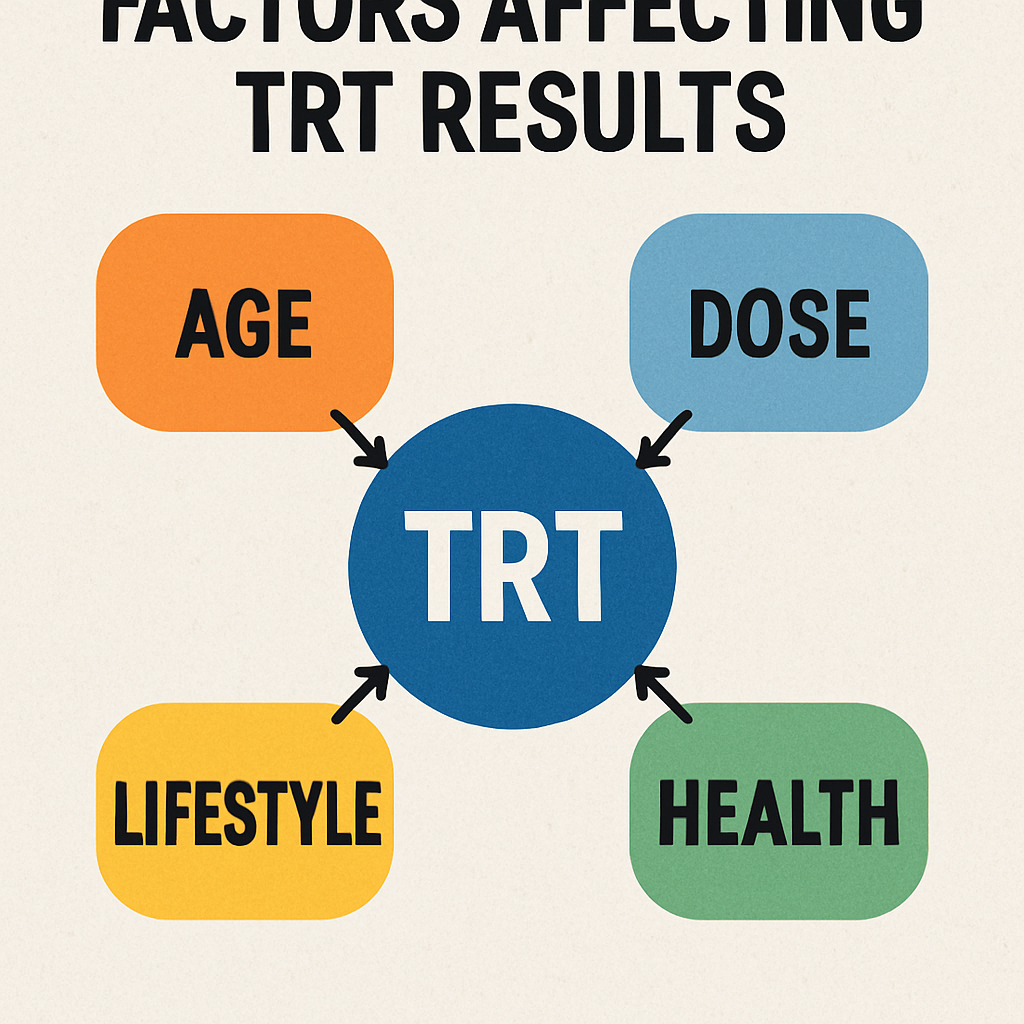Understanding Testosterone Replacement Therapy Results
Testosterone Replacement Therapy (TRT) is a widely recognized treatment for men experiencing low testosterone levels. This therapy can significantly enhance various aspects of physical, emotional, and mental health. However, understanding the results and the timeline for these changes can be somewhat complex, requiring a comprehensive look at the factors influencing the therapy’s effectiveness.
In this article, we’ll delve into the timeline of TRT results, exploring how long it takes for testosterone to take effect and the transformations you might expect. We’ll also examine the intricacies of the therapy itself, factors affecting its outcomes, and realistic before-and-after expectations.
Testosterone Replacement Therapy involves the administration of testosterone to increase its levels in the body. This can be achieved through several methods, including injections, patches, gels, or pellets, each chosen based on individual preference and medical advice.
- Injections: Testosterone injections are one of the most common methods, offering quick absorption into the bloodstream. They require regular visits to a healthcare provider or self-administration, depending on comfort levels.
- Patches and Gels: These methods provide a more gradual release of testosterone. They are applied to the skin and are convenient for daily use, though they may cause skin irritation in some individuals.
- Pellets: Implanted under the skin, pellets offer a long-term solution, releasing testosterone steadily over several months. This method is less common but provides consistent hormone levels.
Low testosterone levels can lead to symptoms such as fatigue, depression, reduced muscle mass, and decreased libido. TRT aims to alleviate these symptoms by restoring testosterone to normal levels, thereby improving quality of life.
- Physical Symptoms: Men with low testosterone often experience a decline in muscle mass and bone density, leading to weakness and an increased risk of fractures. TRT can help counteract these effects.
- Emotional Wellbeing: Depression and anxiety are commonly associated with low testosterone. By stabilizing hormone levels, TRT can improve mood and emotional stability.
- Sexual Health: Reduced libido and erectile dysfunction can significantly affect relationships and self-esteem. TRT can restore sexual function, enhancing intimacy and personal confidence.
One of the most frequent inquiries is, “How fast does testosterone work?” The answer isn’t straightforward as it varies based on the individual and the method of administration. However, there is a general timeline for when you might start noticing changes.
TRT Timeline: What to Expect
- Initial Weeks (1-2 weeks)
In the first few weeks, you might not notice significant physical changes, but some individuals report improved mood and increased energy levels. It’s also common to experience a boost in libido during this initial phase.
- Mood Elevation: Many report feeling less fatigued and more motivated as their energy levels begin to rise.
- Libido Increase: An increase in sexual desire is often one of the first signs that TRT is taking effect, though it can vary among individuals.
- Subtle Energy Shifts: While not drastic, an uptick in overall energy can be noticed, making daily activities more manageable.
- 1 Month
After a month, you might begin to notice slight changes in body composition. Some individuals report feeling stronger or having improved stamina during physical activities. Mood improvements continue, and some may experience better sleep patterns.
- Strength and Stamina: Even though these changes might be minor, they are often the first indicator of TRT’s impact on physical performance.
- Enhanced Sleep: Better sleep quality contributes to improved mood and increased daytime energy.
- Mood Continuation: The mood improvements observed in the initial weeks tend to stabilize, providing a more consistent emotional baseline.
- 3 Months
By the third month, more noticeable changes occur. This is usually when muscle mass begins to increase, and body fat may start to decrease. Strength improvements are more apparent, and you might find workouts becoming more productive. Enhanced libido and mood stability are also commonly reported.
- Muscle Development: Visible muscle growth and definition are often noticeable, especially with a consistent exercise regimen.
- Fat Reduction: A decrease in body fat percentage is typical, contributing to a leaner appearance.
- Workout Efficiency: Exercises become more effective, with increased strength and endurance leading to better overall fitness.
- 6 Months
After six months of TRT, significant improvements in muscle mass and strength are usually evident. Physical transformations become more noticeable, and many experience enhanced motivation and mental clarity. Improvements in bone density and cardiovascular health can also occur.
- Physical Transformation: The body undergoes substantial changes, with increased muscle tone and strength.
- Mental Clarity: Cognitive functions improve, often resulting in better focus and memory.
- Health Benefits: Bone density and cardiovascular health benefits become more pronounced, reducing the risk of age-related health issues.
- 1 Year
A year into TRT, most individuals see substantial changes in body composition, strength, and overall vitality. These changes often include increased muscle mass, reduced body fat, and a more toned physique. The psychological benefits, such as improved mood and cognitive function, are often well-established by this point.
- Sustained Transformation: The changes achieved over the months solidify, leading to long-term physical and mental health benefits.
- Vitality and Wellness: Individuals often report feeling more youthful and vigorous, with a renewed zest for life.
- Cognitive and Emotional Stability: The psychological gains achieved earlier are maintained, providing a stable foundation for ongoing wellbeing.
Factors Affecting TRT Results
It’s important to note that the timeline and extent of results can vary based on several factors:
Dosage and Administration
The dosage and form of testosterone used can significantly impact how quickly and effectively the therapy works. Injections often provide faster results compared to gels or patches, but the ideal method should be determined by your healthcare provider.
- Injection Frequency and Dosage: Regular injections can lead to quicker and more noticeable changes but require precise dosing and scheduling to avoid side effects.
- Gels and Patches: These methods offer a steadier release but may require more time to show effects. They are preferred for those seeking a gradual approach.
- Pellet Implants: While less common, pellets provide consistent testosterone levels, requiring less frequent medical visits.
Individual Health and Lifestyle
Your baseline health, diet, exercise routine, and lifestyle choices can all affect TRT results. Individuals who maintain a healthy diet and regular exercise program may see more pronounced changes.
- Dietary Habits: A balanced diet rich in protein and essential nutrients supports muscle growth and energy levels, enhancing TRT outcomes.
- Exercise Regimen: Regular physical activity accelerates muscle development and fat reduction, making TRT more effective.
- Lifestyle Choices: Avoiding substances like alcohol and tobacco, and managing stress, can improve overall results and wellbeing.
Age and Genetics
Age and genetic factors play a role in how your body responds to testosterone therapy. Younger individuals might experience quicker results compared to older adults.
- Age-Related Response: Younger bodies generally respond more rapidly to hormonal changes, leading to quicker results.
- Genetic Predisposition: Genetics can influence how well an individual responds to TRT, affecting everything from muscle growth to mood improvements.
- Long-Term Potential: Understanding your genetic makeup can help set realistic expectations and tailor the approach for optimal results.
Before and After: Realistic Expectations
TRT can lead to significant transformations, but it’s important to have realistic expectations. While many see improvements in muscle mass, strength, and mood, the extent of these changes varies from person to person.
TRT Before and After: 3 Months
In the first three months, you might notice subtle changes in energy levels, mood, and initial physical improvements. This period is more about laying the groundwork for more noticeable changes down the line.
- Initial Adjustments: The body is adapting to new testosterone levels, which can result in subtle but important changes.
- Foundation Building: This phase sets the stage for more dramatic transformations, emphasizing the need for patience and persistence.
- Expectation Management: Understanding that changes are gradual helps maintain motivation and commitment to the therapy.
TRT Before and After: 6 Months
By six months, the changes become more apparent. Increased muscle mass, improved body composition, and heightened energy levels are common. Psychological improvements, like enhanced mood and focus, often stabilize during this period.
- Visible Progress: Physical changes are more pronounced, offering visual confirmation of the therapy’s effectiveness.
- Psychological Stability: Emotional and cognitive benefits become consistent, contributing to overall wellbeing.
- Lifestyle Integration: By this point, TRT often becomes a seamless part of daily life, with individuals adjusting to their new levels of vitality.
TRT Before and After: 1 Year
After a year, the transformations are usually significant. Most individuals experience a notable improvement in physique, strength, and overall wellbeing. The long-term benefits of TRT, such as improved bone density and cardiovascular health, also become more evident.
- Long-Term Benefits: The cumulative effects of TRT become clear, offering sustained improvements in health and fitness.
- Comprehensive Wellbeing: The combination of physical, emotional, and cognitive gains leads to a more balanced and fulfilling life.
- Sustained Motivation: The significant changes witnessed over a year help maintain enthusiasm and commitment to ongoing therapy.
Conclusion
Testosterone Replacement Therapy can offer numerous benefits, but understanding the timeline for results is crucial for setting realistic expectations. From initial mood improvements to substantial physical changes over the course of a year, TRT can significantly enhance quality of life for those with low testosterone levels.
If you’re considering TRT, it’s important to discuss it with a healthcare provider to determine the best approach based on your individual needs and health status. Remember, patience and consistency are key to achieving the best results with testosterone therapy. Embracing a healthy lifestyle alongside TRT can further amplify the benefits, leading to a more vibrant and fulfilling life.







